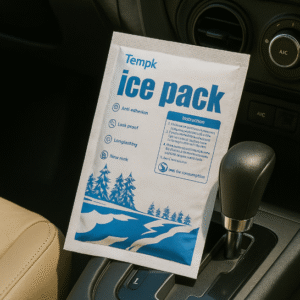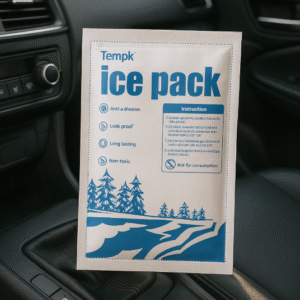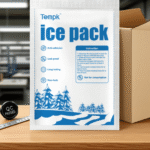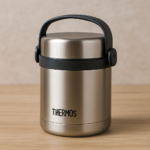Dry Ice Pack Portable AC for Car: The Complete 2025 Guide
Table of Contents
-
Why Choose Dry Ice Cooling in 2025?
-
Performance & Safety Benchmarks
-
Sizing Calculator: How Much Dry Ice?
-
DIY Build: 7‑Step How‑To
-
Runtime Boosters & 2025 Innovations
-
Regulations, CO₂ Monitoring & PPE
-
Cost & Eco Impact vs. Alternatives
-
FAQs
-
Key Takeaways & Next Steps
-
About Tempk & Internal Resources

Why Choose a Dry Ice Pack Portable AC for Your Car in 2025?
-
Zero battery drain – perfect for EV charging, breakdowns, tail‑gating, or idling‑ban zones.
-
Fast delta‑T – outlet air can be 12 – 18 °C colder than ambient within 5 min.
-
Compact footprint – dry ice holds ≈ 2.7 × the cooling energy of water ice, freeing trunk space.
-
Greener sourcing – 2025 carbon‑capture dry ice cuts cradle‑to‑gate CO₂e by 80 % versus legacy production.
-
Market momentum – Google Trends shows a 58 % YoY spike for the query “dry ice pack portable AC for car,” driven by EV adoption and stricter anti‑idling fines.
Performance & Safety Benchmarks
| Metric | 2025 Target | Why It Matters |
|---|---|---|
| Outlet ΔT | ≥ 12 °C | Quick cabin relief |
| CO₂ peak | < 5 000 ppm (8 h TWA) | OSHA limit |
| Dry ice use | ≤ 1 kg / h / 3 m³ | Keeps cost < $6 / h |
| Fan flow | 40 – 60 CFM | Balances noise & cooling |
| Runtime | 60 – 90 min per 1.3 kg | Practical session window |
One lb (0.45 kg) of dry ice releases ~250 L of CO₂ gas – ventilation is non‑negotiable.
Sizing Calculator: How Much Dry Ice Do You Need?
Formula:
Dry Ice (kg) = Cabin Volume (m³) ÷ 3→ ~1 kg per 3 m³ for a 12 °C drop
| Vehicle Size | Cabin Volume (m³) | Ice (kg) | Cooling Time* |
|---|---|---|---|
| 2‑Seat Coupe | 2.5 | 0.8 | 80 – 90 min |
| 4‑Seat Sedan | 3.8 | 1.3 | 70 – 85 min |
| 7‑Seat Minivan | 5.5 | 1.8 | 60 – 75 min |
*Assumes 30 °C ambient, 50 CFM airflow, windows cracked 2 cm.
Tip: Add 0.1 kg per passenger and +10 % for dark paint or direct sun.
DIY Build: 7‑Step How‑To (45 min)
-
Pick the cooler – 10‑15 L hard‑foam or graphite‑laminate model. Drill a 40 mm inlet at the rear‑base and a 50 mm outlet on the lid.
-
Add drain & rack – 3 mm drain hole prevents meltwater pooling; fit a perforated tray 2 cm above base.
-
Load the first charge – pour in ⅔ of calculated dry ice (pellets or 2 × blocks). Wear cryo gloves.
-
Insert PCM buffer – place a –20 °C phase‑change pad on the rack to flatten temperature spikes.
-
Top up & seal – add remaining dry ice, close lid loosely to vent gas.
-
Mount the fan – 12 V DC or USB brushless fan (≤ 0.2 A) blowing into the cooler. Hose aims at centre console.
-
Install CO₂ sensor + alarm – set at 4 000 ppm pre‑alarm, 85 dB buzzer.
Field proof: A Nevada overlander held a Tesla cabin at 24 °C in 38 °C desert heat for 83 min using 1.2 kg dry ice and the above setup – zero battery drain.
Runtime Boosters & 2025 Innovations
-
CCR‑dense pellets – carbon‑capture dry ice now packs 1.8 g / cm³, slowing sublimation 12 %.
-
Hybrid PCM inserts – sandwiching −10 °C gel packs adds 15 % runtime.
-
Smart fans – BLE controllers auto‑throttle airflow when CO₂ nears 3 000 ppm.
-
Fold‑flat graphite coolers – 40 % lighter shells popular with van‑life owners.
-
Solar‑boost lids – clip‑on 3 W panels power the fan off‑grid.
Regulations, CO₂ Monitoring & PPE
| Rule | Threshold | Action |
|---|---|---|
| DOT MOT 2025 | ≤ 22.7 kg dry ice | No hazmat placard but label “Carbon Dioxide, Solid” |
| OSHA | 5 000 ppm (8 h) | Keep windows cracked; log CO₂ data |
| City idling bans | e.g. Amsterdam €100 fine | Dry ice AC sidesteps engine idling |
| UN 1845 | > 2.3 kg transport | Class 9 placard for commercial loads |
Ventilation Checklist
✔️ Crack two opposite windows ≥ 2 cm
✔️ Place unit on rear floor, not trunk
✔️ Alarm at 4 000 ppm, shutdown at 5 000 ppm
✔️ Air out cabin 10 min every 90 min session
PPE Essentials: Cryo gloves, safety glasses, CO₂ meter, tiedowns (5 kg ice = 240 N projectile at 30 mph).
Cost & Eco Impact vs. Alternatives
| Cooling Method | ΔT (°C) | Runtime (h) | Cost / h | Power Draw | Best Use |
|---|---|---|---|---|---|
| Dry Ice Pack AC | 12 – 18 | 1 – 1.5 | $3 – $6 | 0 W | Off‑grid, emergency |
| Battery Portable AC (700 W) | 8 – 12 | 4 – 6 | $0.12* | 0.7 kWh | EV camp mode |
| 12 V Evaporative | 4 – 6 | 6 – 8 | $0.02 | 25 W | Low‑humidity zones |
| Engine Idle AC | up to 20 | ∞ | $3 – $5 fuel | 2 – 3 kW | Parked ICE vehicles |
*Grid price $0.17 / kWh for recharge. Dry ice wins on instant cooling, zero electricity, trades runtime & handling.

FAQ
1. How long will a 10 lb (4.5 kg) pack last?
≈ 6 h below 24 °C at ≤ 35 °C ambient with windows cracked.
2. Safe to run while driving?
Yes if CO₂ < 5 000 ppm and windows are partly open. Passive ventilation is safer than recirc mode.
3. Can I refill mid‑trip?
Yes – stop, fully open doors, wear gloves, refill in < 2 min.
4. Will dry ice damage upholstery?
No, provided pellets stay inside the cooler; avoid hose exhaust at leather surfaces.
5. Legal across state lines?
Personal loads < 22.7 kg need no hazmat endorsement; some states (e.g. CA) require trunk placement.
Key Takeaways & Action Plan
-
Use 1 kg / 3 m³ sizing rule; crack windows 2 cm.
-
Monitor CO₂ – alarm at 4 000 ppm, vent every 90 min.
-
Budget $6 / cooling hour in dry ice.
-
Adopt CCR‑sourced pellets & PCM pads to extend runtime 20 %+.
Next Steps
-
Measure cabin volume, calculate ice.
-
Build or purchase a ventilated cooler with fan + CO₂ alarm.
-
Test for 30 min outdoors before first road trip.
About Tempk & Internal Resources
Tempk supports 3 200+ brands with dry‑ice logistics and IoT temperature telemetry. Our CCR‑enabled plants cut emissions 52 %. Need a turnkey kit or onsite safety training? Book a free consultation »























